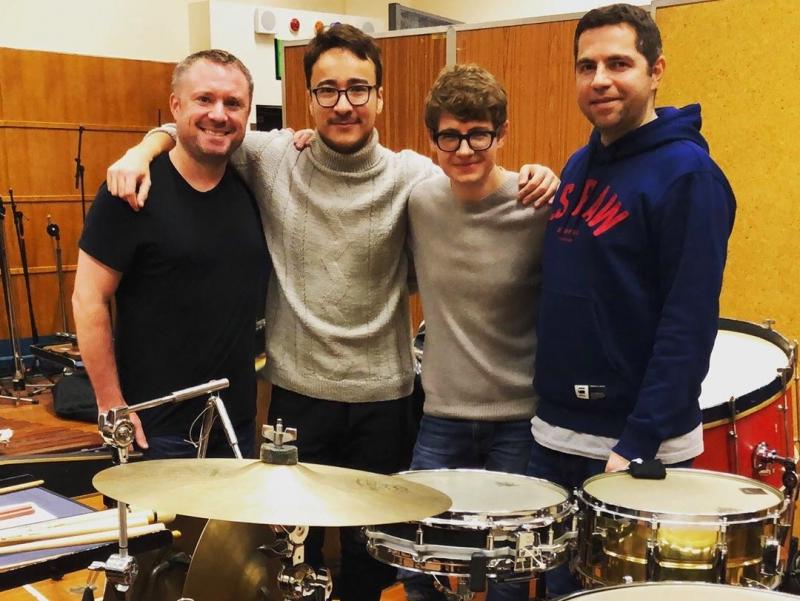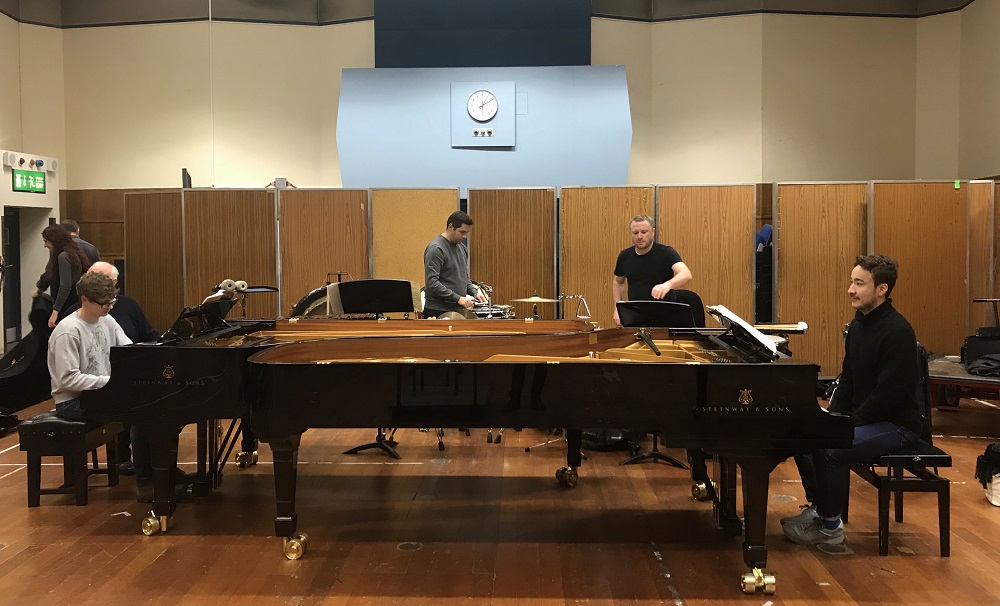Kolesnikov, Tsoy, Currie, Walton, Wigmore Hall review - mesmerising sonorities | reviews, news & interviews
Kolesnikov, Tsoy, Currie, Walton, Wigmore Hall review - mesmerising sonorities
Kolesnikov, Tsoy, Currie, Walton, Wigmore Hall review - mesmerising sonorities
Every note made to count in Bartók, Britten and Ravel

Fine-tuning piano sound to Wigmore acoustics can elude even the greatest. Add a second Steinway and a wide range of percussion instruments, and the risks would seem to be hugely increased.
Even a risky transcription worked: Ravel's Rapsodie espagnole for two pianos – as its third-movement Habanera was originally conceived 12 years before the orchestral masterpiece – and a range of percussion kept its essence and yielded new revelations. The late percussionist Peter Sadlo's arrangement to include timpani, castanets and tambourine, inter alia, added the same colours they bring to the symphonic version, with no flashy extras but all the necessary glitter in the second and fourth movements. All you miss, perhaps, is a harp and some of those glissandi string effects with which Ravel spooks us in his finale, but the pianists’ subtlety held the mesmerising key throughout. Britten’s Two Lullabies of 1936 served as a pianos-only intermezzo, but a fascinating one; the staccato togethers-and-not-quites at the end of the first were masterly-mesmerising and the "Lullaby for a Retired Colonel" strutted its stuff like the lightest of Mahlerian funeral-march parodies.  Bartók’s Sonata for two pianos and percussion is a solitary miracle of the 20th century repertoire, albeit inspired in part by the instrumental forces of Stravinsky's Les noces – Kolesnikov and Tsoy gave a superb performance of the latter's Concerto for two pianos at the 2018 London Piano Festival – and has never seemed to me more so than in this performance (even with the likes of Kovacevich and Argerich in mind). The logic of Bartók's slow-fast first movement as it swerves from supernatural chords to bracing dance music isn’t easy to follow; with Tsoy especially relaxed in making some of it look, as well as sound, playful, you just went with the flow.
Bartók’s Sonata for two pianos and percussion is a solitary miracle of the 20th century repertoire, albeit inspired in part by the instrumental forces of Stravinsky's Les noces – Kolesnikov and Tsoy gave a superb performance of the latter's Concerto for two pianos at the 2018 London Piano Festival – and has never seemed to me more so than in this performance (even with the likes of Kovacevich and Argerich in mind). The logic of Bartók's slow-fast first movement as it swerves from supernatural chords to bracing dance music isn’t easy to follow; with Tsoy especially relaxed in making some of it look, as well as sound, playful, you just went with the flow.
Currie could stun with a single cymbal stroke, Walton with off-kilter xylophone notes. With Kolesnikov now changing places with Tsoy as first pianist (rehearsal pictured above), chord clusters and trills resonated, transitions were deft, the mixture of freedom and absolute precision, lightness and weight, jaw-dropping. It’s hard to imagine a performance of this masterpiece which would deliver the whole rainbow of effects and substance better than this. And even a recording of the event – the concert was broadcast live on BBC Radio 3 – can’t ever capture the absolute wonder of such sounds live.
- Listen to this concert for the next month on the BBC iPlayer
- Colin Currie Group play Steve Reich's Drumming at the Hayward Gallery on 5 and 6 December
- Samson Tsoy in recital at Cedars Hall, Wells Cathedral School, on 5 December
- Pavel Kolesnikov's next Wigmore Hall recital is on 3 January 2020
- More classical reviews on theartsdesk
rating
Explore topics
Share this article
The future of Arts Journalism
You can stop theartsdesk.com closing!
We urgently need financing to survive. Our fundraising drive has thus far raised £49,000 but we need to reach £100,000 or we will be forced to close. Please contribute here: https://gofund.me/c3f6033d
And if you can forward this information to anyone who might assist, we’d be grateful.

Subscribe to theartsdesk.com
Thank you for continuing to read our work on theartsdesk.com. For unlimited access to every article in its entirety, including our archive of more than 15,000 pieces, we're asking for £5 per month or £40 per year. We feel it's a very good deal, and hope you do too.
To take a subscription now simply click here.
And if you're looking for that extra gift for a friend or family member, why not treat them to a theartsdesk.com gift subscription?
more Classical music
 Jansen, LSO, Pappano, Barbican review - profound and bracing emotional workouts
Great soloist, conductor and orchestra take Britten and Shostakovich to the edge
Jansen, LSO, Pappano, Barbican review - profound and bracing emotional workouts
Great soloist, conductor and orchestra take Britten and Shostakovich to the edge
 Jakub Hrůša and Friends in Concert, Royal Opera review - fleshcreep in two uneven halves
Bartók kept short, and a sprawling Dvořák choral ballad done as well as it could be
Jakub Hrůša and Friends in Concert, Royal Opera review - fleshcreep in two uneven halves
Bartók kept short, and a sprawling Dvořák choral ballad done as well as it could be
 Hadelich, BBC Philharmonic, Storgårds, Bridgewater Hall, Manchester review - youth, fate and pain
Prokofiev in the hands of a fine violinist has surely never sounded better
Hadelich, BBC Philharmonic, Storgårds, Bridgewater Hall, Manchester review - youth, fate and pain
Prokofiev in the hands of a fine violinist has surely never sounded better
 Monteverdi Choir, ORR, Heras-Casado, St Martin-in-the-Fields review - flames of joy and sorrow
First-rate soloists, choir and orchestra unite in a blazing Mozart Requiem
Monteverdi Choir, ORR, Heras-Casado, St Martin-in-the-Fields review - flames of joy and sorrow
First-rate soloists, choir and orchestra unite in a blazing Mozart Requiem
 Cho, LSO, Pappano, Barbican review - finely-focused stormy weather
Chameleonic Seong-Jin Cho is a match for the fine-tuning of the LSO’s Chief Conductor
Cho, LSO, Pappano, Barbican review - finely-focused stormy weather
Chameleonic Seong-Jin Cho is a match for the fine-tuning of the LSO’s Chief Conductor
 Classical CDs: Shrouds, silhouettes and superstition
Cello concertos, choral collections and a stunning tribute to a contemporary giant
Classical CDs: Shrouds, silhouettes and superstition
Cello concertos, choral collections and a stunning tribute to a contemporary giant
 Appl, Levickis, Wigmore Hall review - fun to the fore in cabaret and show songs
A relaxed evening of light-hearted fare, with the accordion offering unusual colours
Appl, Levickis, Wigmore Hall review - fun to the fore in cabaret and show songs
A relaxed evening of light-hearted fare, with the accordion offering unusual colours
 Lammermuir Festival 2025, Part 2 review - from the soaringly sublime to the zoologically ridiculous
Bigger than ever, and the quality remains astonishingly high
Lammermuir Festival 2025, Part 2 review - from the soaringly sublime to the zoologically ridiculous
Bigger than ever, and the quality remains astonishingly high
 BBC Proms: Ehnes, Sinfonia of London, Wilson review - aspects of love
Sensuous Ravel, and bittersweet Bernstein, on an amorous evening
BBC Proms: Ehnes, Sinfonia of London, Wilson review - aspects of love
Sensuous Ravel, and bittersweet Bernstein, on an amorous evening
 Presteigne Festival 2025 review - new music is centre stage in the Welsh Marches
Music by 30 living composers, with Eleanor Alberga topping the bill
Presteigne Festival 2025 review - new music is centre stage in the Welsh Marches
Music by 30 living composers, with Eleanor Alberga topping the bill
 Lammermuir Festival 2025 review - music with soul from the heart of East Lothian
Baroque splendour, and chamber-ensemble drama, amid history-haunted lands
Lammermuir Festival 2025 review - music with soul from the heart of East Lothian
Baroque splendour, and chamber-ensemble drama, amid history-haunted lands
 BBC Proms: Steinbacher, RPO, Petrenko / Sternath, BBCSO, Oramo review - double-bill mixed bag
Young pianist shines in Grieg but Bliss’s portentous cantata disappoints
BBC Proms: Steinbacher, RPO, Petrenko / Sternath, BBCSO, Oramo review - double-bill mixed bag
Young pianist shines in Grieg but Bliss’s portentous cantata disappoints

Add comment